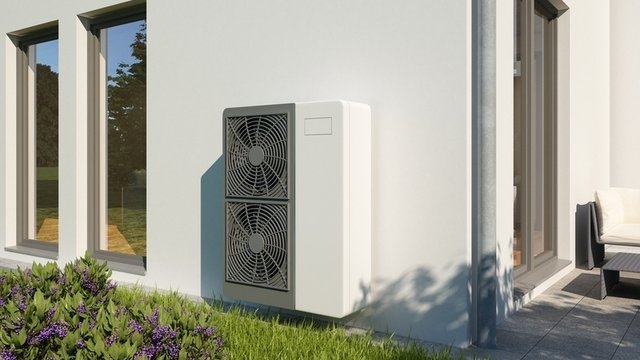

Aerothermal energy is a sustainable technology for providing heating, cooling and hot water. It is an efficient solution for residential and commercial projects based on sustainable architecture.
This and other energy systems with low environmental impact are studied in the master in Architecture offered by Universidad Europea.
What is aerothermal energy?
Aerothermal energy is a heating, cooling and domestic hot water production technology that uses the energy contained in the outside air.
It works by means of a heat pump that extracts heat from the ambient air and transfers it to the inside of a building. It can be used to heat or cool the space, depending on the needs.
Aerothermal heating offers multiple advantages for the consumer and for the environment.
- Energy efficiency: it can produce up to three to four times more energy than it consumes in the form of electricity, making it a sustainable consumption option.
- Renewable energy: it uses a free, renewable energy source: air.
- Reduced emissions: emits less CO2 compared to traditional systems using fossil fuels.
- Versatility: provides heating, cooling and domestic hot water with a single system.
- Low maintenance: Aerothermal systems generally require less maintenance than other heating and cooling systems.
However, there are also some drawbacks to consider when choosing this thermal comfort system.
- Inefficiency in extremely cold climates: extreme cold decreases its efficiency, although the most advanced technologies are already able to operate efficiently in low temperatures.
- Initial investment: installation cost can be higher than other systems.
- Space requirement: requires space for the outdoor unit and, in some cases, for hot water storage tanks.
Aerothermal systems by pump type
Aerothermal systems are divided according to the type of pump they use and their intended use.
- Aerothermal heating and domestic hot water (DHW): works through an air-water heat pump, which transfers the heat from the outside air to the water circulating in the heating system and to the hot water tanks. It is ideal for radiators, underfloor heating and DHW.
- Aerothermal for heating, cooling and DHW: it works through a reversible air-water heat pump that, in addition to providing heating and DHW, can reverse its operation to provide cooling.
- Aerothermal for space air conditioning: works through an air-to-air heat pump that extracts heat from the outside air and transfers it directly to the indoor air through indoor units (such as splits).
How does aerothermal energy work?
To understand how aerothermal energy works, we will first explain its different parts.
The outdoor unit is made up of two components:
- Evaporator: this is where the refrigerant fluid is located, which absorbs heat from the outside air.
- Compressor: the heart of the system, which compresses the refrigerant and raises its temperature.
The indoor unit is made up of three components:
- Heat exchanger (condenser): this is where heat is transferred from the refrigerant to the water (in air-to-water systems) or to the air (in air-to-air systems).
- DHW tank: in air-to-water systems, this is where the domestic hot water is stored.
- Controller: manages the operation of the system, temperature and other parameters.
The outside air enters this circuit and passes through each of these components in a different way depending on the mode in which the system is to be used.
When you want to use it in heating mode:
- The outdoor unit extracts heat from the outside air even at low temperatures.
- The compressor increases the temperature of the refrigerant that has absorbed the heat.
- This heat is transferred to a heating system (radiators, underfloor heating, etc.) or to a domestic hot water system.
When it is to be used in cooling mode:
- The outdoor unit extracts heat from inside the dwelling and expels it to the outside air.
- The cold refrigerant circulates to the indoor unit, where it absorbs the heat from the indoor air, cooling the environment.
What is aerothermal energy used for?
Aerothermal energy has many applications, both in residential, commercial and industrial applications.
Residential and commercial applications
- Heating homes, offices and commercial buildings: aerothermal is particularly efficient when combined with underfloor heating systems. It can also be used with low temperature radiators.
- Cooling of homes, offices and commercial buildings: air-to-air heat pumps can provide centralised cooling, while ducted systems and split units allow cooling of individual rooms.
- Domestic hot water (DHW) and swimming pool heating: air-to-water heat pumps can heat water for domestic use.
Industrial applications
- Hall heating and cooling: aerothermal systems can maintain the right temperature in large industrial spaces.
- Process water heating: In industries that require hot water for specific processes, aerothermal can be an efficient and economical option.
How to work with aerothermal energy
The field of aerothermal energy covers a variety of roles, from design and installation to maintenance and research or development.
- Aerothermal system designer: is responsible for designing systems, calculating heat loads and selecting appropriate equipment and components. Requires a background in mechanical or thermal engineering.
- Aerothermal systems installer: installers of heat pumps and associated systems in residential, commercial or industrial buildings. They need technical training and skills in plumbing and electricity.
- Maintenance technician: they perform preventive and corrective maintenance and repair system failures. Like installers, they need technical training and skills in plumbing and electricity.
- Renewable energy consultant: they advise clients on the advantages and possibilities of aerothermal energy, carry out feasibility studies and propose customised solutions. They have in-depth knowledge of aerothermal technologies, analytical and communication skills.
- Researcher or developer of new technologies: they research new technologies and improvements in aerothermal systems. They require advanced training in engineering, research and development in the field of energy and technology.